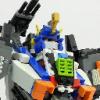Search the Community
Showing results for tags 'chemistry'.
Found 3 results
-
About The idea represents ball-and-stick models of molecules using LEGO bricks. Atoms are made of cubes with technic holes. Bonds are made using soft axles. Many chemical compounds can be easily and quickly created by connecting and disconnecting atoms. To represent valence electrons and bond abilities, the hydrogen atom has one connection point (one technic hole), oxygen has two, etc. Soft axles enable the creation of complex compounds with angled, double, or even triple bonds. Many variations can be made by applying different stickers to the top tiles of atoms. For a set, I have selected 80 atoms and an adequate number of bonds, for a total of 742 LEGO bricks. I have already successfully used this system to show my kids the difference between atoms, molecules, and various compounds. What you can see on the images All molecules in the proposed set. Selection of gases: ammonia, nitrogen molecule, carbon dioxide, oxygen molecule, and hydrogen molecule. Molecules of liquids: sulfuric acid, water, chloroform. Organic compounds: methane, ethane, methanol, ethanol, and benzene. Solid matter: a unit cell of silicon dioxide. Overview of atoms. Two versions are presented: the top one has only simple chemical symbols. The bottom one also shows the proton number and oxidation state. Photo of my real build of molecules. System The idea is the system. One can take only a few bricks and switch top tiles with stickers, or one can build a whole periodic table of elements. However, for most molecules, one needs multiple hydrogens, but helium is not used at all (because it does not create molecules under normal conditions). Changing bonds is very quick, so one can also demonstrate chemical reactions. Two possibilities For myself, I have used simple paper stickers with a chemical symbol, proton number, and oxidation state. The oxidation state was quite easy to explain; kids understood that the number of 'holes' in the element is relevant to the number of 'bonds' the element can make. Sulphur is good to show that oxidation states can differ. The atomic number was perfect for explaining why CO2 falls down to bottom in a standard atmosphere made mostly of lighter nitrogen molecules. The other possibility is to make stickers with only chemical symbols, as shown in most images. Because I had issues uploading images to the Lego ideas, I used it for most images. There is some rule that texts have to be readable, and in the first image, that was the only way to make all texts readable. Why Kids were asking about atoms/molecules/matter etc. So I thought I will find some nice chemistry system using lego and explain the topic. I have found several chemistry Lego systems or ideas, yet all seemed quite complex or too abstract. So I tried to think about something more easy to understand, and easy to build. If you like it, you can support it on Ideas: https://ideas.lego.com/projects/1f7cf61f-3858-4bf5-94bc-b28b32233232
-

[MOC] Microscope Transformer from Set 70842: Emmet's Couch Mech
alanyuppie posted a topic in LEGO Sci-Fi
Hi guys, In between my major LEGO projects that sucked me many many weeks (months even) of time to complete .. I took a breather by grabbing a lego set and build (yet again) a LEGO Transformer. LEGO set 70842:Emmet's Couch Mech is from LEGO Movie 2 theme and only recently I managed to get it at 50% off. What a bargain! Since the set itself is officially a mech, so most of the parts are useful to build robots as well. The core design was completed by day 3... and I spent another 2 days more to refine it. A microscope mode was created purely out of experimentations since this lego set doesn't have wheels (for land based mode) or adequate number of wedge/slopes (for swooshable plane/space jet mode). Transforming between modes doesn't require reassembly of parts. I'm very pleased to discover this set has parts for me to build the robot fingers as well , compared to just knuckles with holes in them. No wheels ? No problem! here's an extra hover tank mode. INSTRUCTIONS BELOW! Note: children might require adult supervision though. If you're having problems following the building instructions above, you can pay a visit to my blog link below where I posted a detailed instructions with more detailed steps for beginners to follow: http://alanyuppie.blogspot.com/2019/08/instructions-for-lego-transformer.html Have fun! -
Hello I'd like to present to you my latest work showing famous Noble Prize winner - Maria SKłodowska Curie in her laboratory. This MOC is a part of bigger project by which in this year my community (Zbudujmy To) celebrates 100th anniversary of regaining independence by Poland. Vignettes and little dioramas are my favorite forms of LEGO creation and in this one I tried to depict the laboratory as well as possible with various furniture and lab equipment. Additionally, I submitted this project on LEGO Ideas, where you can find some more facts about this model: https://ideas.lego.com/projects/99146fd7-3d4a-497a-a050-ac1757e15e95 Laboratory of Maria Skłodowska-Curie by crises_crs, on Flickr Laboratory of Maria Skłodowska-Curie by crises_crs, on Flickr Laboratory of Maria Skłodowska-Curie by crises_crs, on Flickr Laboratory of Maria Skłodowska-Curie by crises_crs, on Flickr Laboratory of Maria Skłodowska-Curie by crises_crs, on Flickr Laboratory of Maria Skłodowska-Curie by crises_crs, on Flickr Laboratory of Maria Skłodowska-Curie by crises_crs, on Flickr Laboratory of Maria Skłodowska-Curie by crises_crs, on Flickr
- 18 replies
-
- laboratory
- chemistry
- (and 7 more)
